Three women killed in random attacks by homeless men: What does it reveal about America’s crime wave?
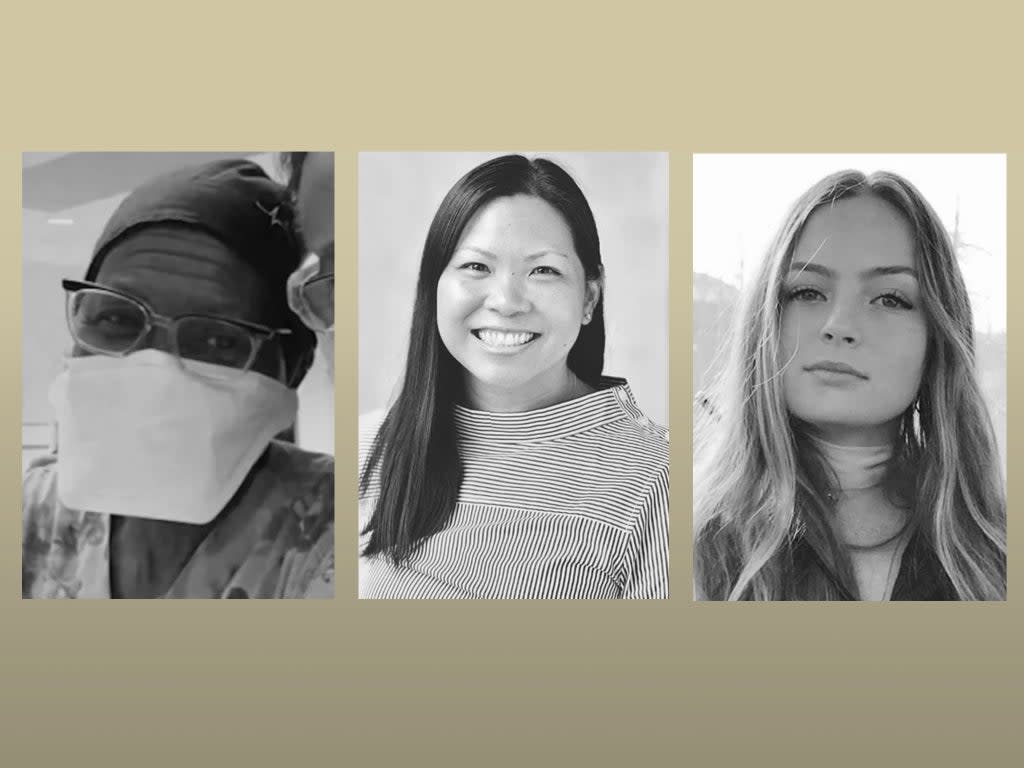
Michelle Alyssa Go was catching a train. Sandra Shells was waiting for a bus. Brianna Kupfer was working her shift in a furniture store.
All three women were then murdered in what appears to be random acts of senseless violence by homeless men.
Their killings, which all took place across just three days last week, have once again thrust concerns around a rise in violent crime and homelessness in America’s major cities into the spotlight.
Ms Go was standing on the platform at Times Square station in New York City at around 9:40am on Saturday morning.
The 40-year-old, who lived on the Upper West Side of Manhattan and worked for consulting giant Deloitte, was pushed in front of a subway train in what authorities described as an “unprovoked attack”. She died at the scene.
Martial Simon, a 61-year-old homeless man, was arrested for her murder soon after when police said he boarded a train and then approached some officers, telling them what he had done.
According to Mr Simon’s sister, he had been suffering from mental illness long before he allegedly pushed the Asian-American woman to her death.
Josette Simon told the New York Post that her younger brother suffers from schizophrenia and that she once begged a hospital not to release him because she knew he would stop taking his medication.
The last time they spoke, he told her “they” were hiding in closets, watching him, she said.
Following his arrest, Mr Simon - who has been arrested multiple times - claimed he killed Ms Go because he is “God”.
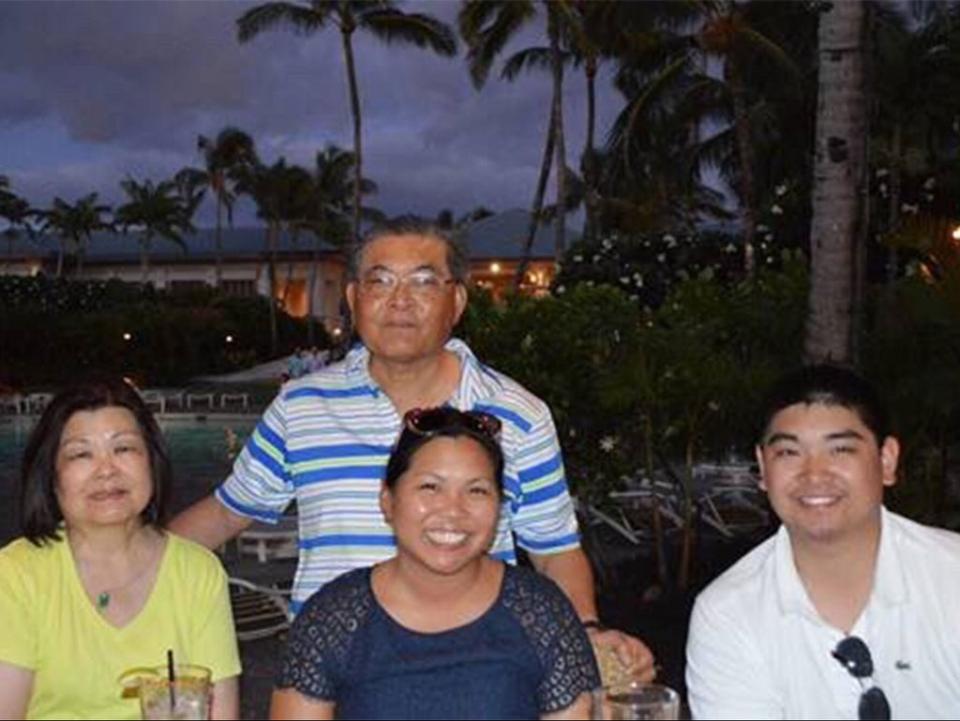
Police in Los Angeles have said the man accused of killing Ms Shells also attacked her “without provocation and for no reason”.
For the 70-year-old, it was a normal day commuting to her job as a nurse at Los Angeles County-USC Medical Center early on Thursday morning.
She was waiting at a bus stop in downtown Los Angeles when she was punched in the head by Kerry Bell, causing her to fall and strike her head on the ground, according to the LAPD.
Days later, Ms Shells passed away from her injuries in the same hospital he had dedicated 38 years of her life to working in. Neighbours and hospital officials say she planned to retire soon.
Mr Bell, a 48-year-old homeless man with multiple arrests on his record, was found sleeping close by to the scene of the attack and was arrested and charged with attempted murder.
Less than nine hours after Ms Shells was attacked in downtown LA, Ms Kupfer was found dead in a pool of blood inside the high-end furniture store where she worked in an affluent area of the city.
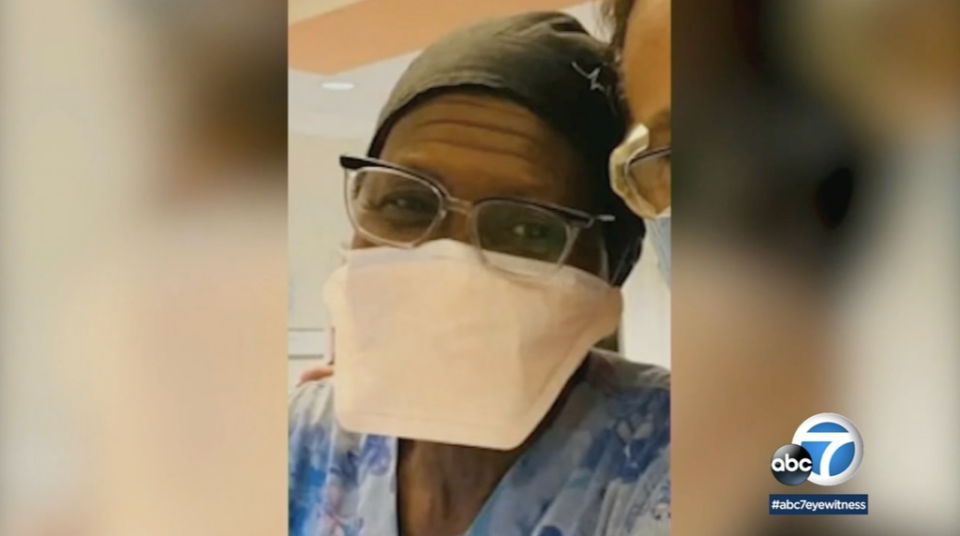
The 24-year-old UCLA grad student was working her shift as a consultant at Croft House on North La Brea Avenue at around 1:50pm on Thursday afternoon.
Shawn Laval Smith, who investigators believe to be homeless, walked into the store and stabbed her to death.
Surveillance footage captured him calmly strolling out the back door of the store and down an alley away from the scene.
A customer found Ms Kupfer bleeding on the floor around 20 minutes later and she was pronounced dead at the scene.
Five days on, investigators are still searching for the suspect who is believed to have attacked the 24-year-old at random. A reward for information leading to the arrest of the killer topped $250,000 on Tuesday.
Ms Kupfer’s devastated father Todd Kupfer blamed the rise in crime in the city for his daughter’s murder and hit out at politicians for allowing criminals to walk the streets.
“Crime is truly spiking, and we have a lot of criminals on the streets that shouldn’t be out,” he told Fox News.
“We have a lot of politicians that somehow forgot about people and think the key to getting elected is to support the lowest rung of our society and to give them rights and somehow that’s the answer to getting votes.”

America’s crime wave
Much has been made about the rise in crime across major cities over the last year, fuelling fears that the US is heading back to the dark days of the 1970s to 1990s when crime gripped vast swathes of the country.
In New York City, violent crime reached its highest level in six years during 2021.
NYPD data shows that the number of major felonies - consisting of murder and non-negligent manslaughter, rape, robbery, felony assault, burglary, grand larceny and grand larceny auto - topped 100,000 for the first time since 2016.
A total of 102,731 major felonies were recorded, a rise of 7.5 percent from 95,593 felonies in 2020.
The last time the tally was higher than this was in 2015, when 105,453 felonies were recorded.
Individually, each of the major felonies rose in the last year, with the exception of burglary which fell by 17.3 percent.
Murders rose 3.8 percent to 486 in 2021 - the highest number in a decade - and felony assaults were up 10.9 percent in a single year.
However, while the figures show an undeniable rise, this is still far lower than the crime rates seen back in the 1990s.
Back in 1990, there was more than five times the number of major felonies as in 2021, with 527,257 that year.
In 2000, there was still close to double the number in 2021, with 184,652 recorded.
It’s a similar story in LA, where LAPD figures reveal there was almost three times fewer violent crimes in 2021 than three decades ago in the 1990s.
The number of violent crimes stood at 88,919 in 1992, compared to the 30,078 recorded last year.
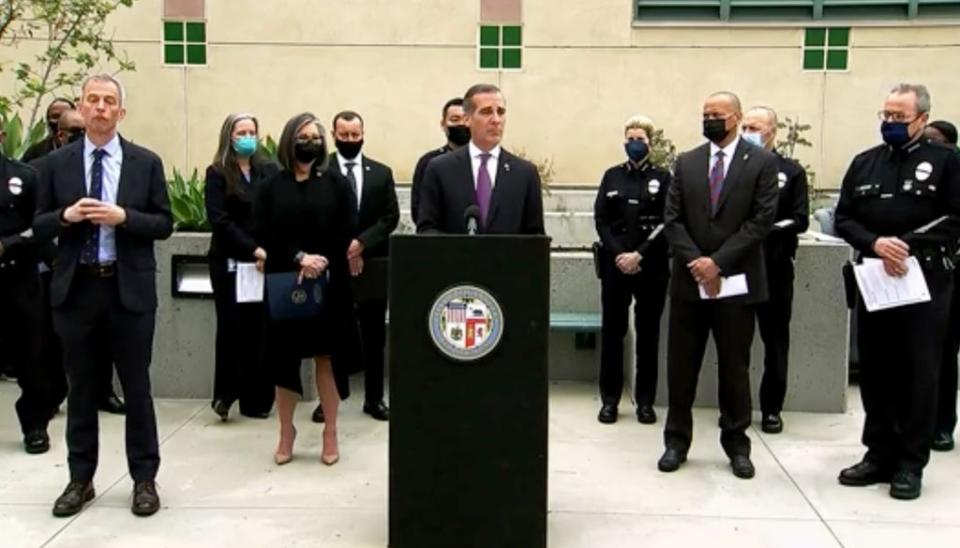
That said, violent crimes did rise 3.9 percent year-on-year in 2021, and more people were victims of shootings than in any other year since 2008.
2021 similarly saw homicides climb to the highest number in 15 years, with 397 murders - a 11.8 percent rise from 2020 and a 53.9 percent rise from a pre-pandemic 2019.
Announcing the figures in a press conference last week, LA Mayor Eric Garcetti said the rise in violent crime was the result of the events of the last two years.
“We have two things together: The trauma of the past two years and the mental health crisis that came out of this pandemic. And we have a lot more guns that are out there,” he said.
“Those things together have caused us to see more violence.”
Homelessness crisis
Among the homeless community specifically, experts say they have noticed a rise in violence throughout the pandemic.
Rev. Andy Bales, CEO and president of Union Rescue Mission on Skid Row in Los Angeles, tells The Independent that what he has seen in the last two years is unlike anything he has seen during the 35 years he has been working to support people living in homelessness.
“I’m certainly seeing violence and behaviours among people devastated by homelessness that I’ve never seen in the last 35 years,” he says.
“Most often it’s violence towards others who are homeless and they suffer the brunt of it.
“But in LA, 70 percent of people devastated by homelessness are on the streets and so this presents conditions where pedestrians on their way to work will meet people who are in different states of mental illness.”
He adds: “In LA, there are encampments everywhere you go and people who are struggling are everywhere.”
While New York has a “right to shelter” law requiring the city to provide emergency shelter to homeless people, Los Angeles does not have a law like this.
Consequently, more homeless people are sleeping in tents and makeshift camps in the streets of the city than in shelters.
Around 8,000 people live in the infamous Skid Row neighbourhood in downtown LA, known to be one of the biggest homeless encampments across the country.
“Nobody leaves people on the streets like LA leaves people on the streets and this impacts homeless people mentally, physically, socially - in every way,” says Rev. Bales.
Rev. Bales says when the pandemic came along it took its toll on the mental health of the already vulnerable population.
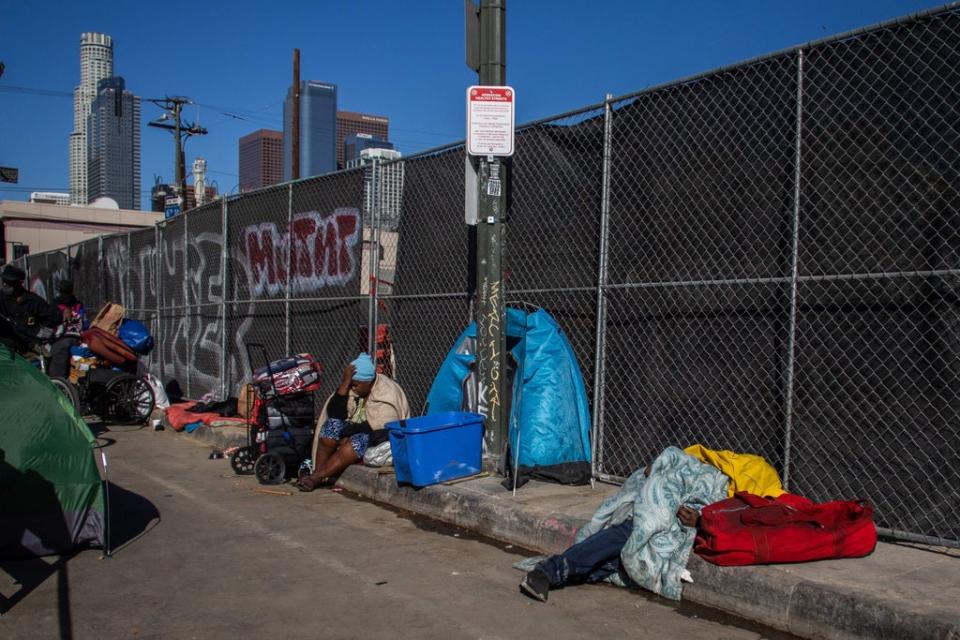
“The pandemic and the divisiveness in the world right now have exacerbated the already fragile mental health conditions of so many,” he says.
“If you and I are honest, every day we’re a bit on the brink with all that’s going on in the world so imagine somebody already in a fragile condition now being pressed on all sides by what we’re facing.
“It’s an overwhelming time and there’s nothing that exacerbates fragile mental health even more like leaving people on the streets with nowhere to go and no real help.”
‘Cyclical’ mental health issues
Jacquelyn Simone, policy director of the Coalition for the Homeless, has also noticed that housing instability, substance abuse and mental illness has worsened for the homeless population of in New York City during the pandemic.
“It has been very challenging for homeless New Yorkers to access mental health care and substance abuse services because the health service has been so overwhelmed by the pandemic,” she tells The Independent.
“Some psychiatric units were repurposed as part of the pandemic response and providers that switched to telemedicine were not accessible to homeless people who don’t have access to technology.
“So when people have been in the midst of mental health crises they have not been able to access the care they need.”
Mental health issues and homelessness are “cyclical”, she says, as mental illness can lead people into homelessness while the instability of homelessness can also exacerbate the underlying illness.
“People need the stability of housing so they can address substance addiction and mental health issues,” she says.
Research from the Coalition for the Homeless has revealed that homelessness in New York City has reached the highest levels since the Great Depression of the 1930s, standing 20 percent higher than a decade ago.
In October, there were 48,723 homeless people including 15,346 children sleeping in the city’s shelters.
The volume of single adults in shelters has skyrocketed 92 percent in the last decade to a near-record level of 18,370 in October 2021.
And these figures far from reveal the true picture, says Ms Simone.
This data only captures the number of people sleeping in homeless shelters and not the vast numbers of people sleeping in tents and in doorways on the streets and in subway stations around the city.
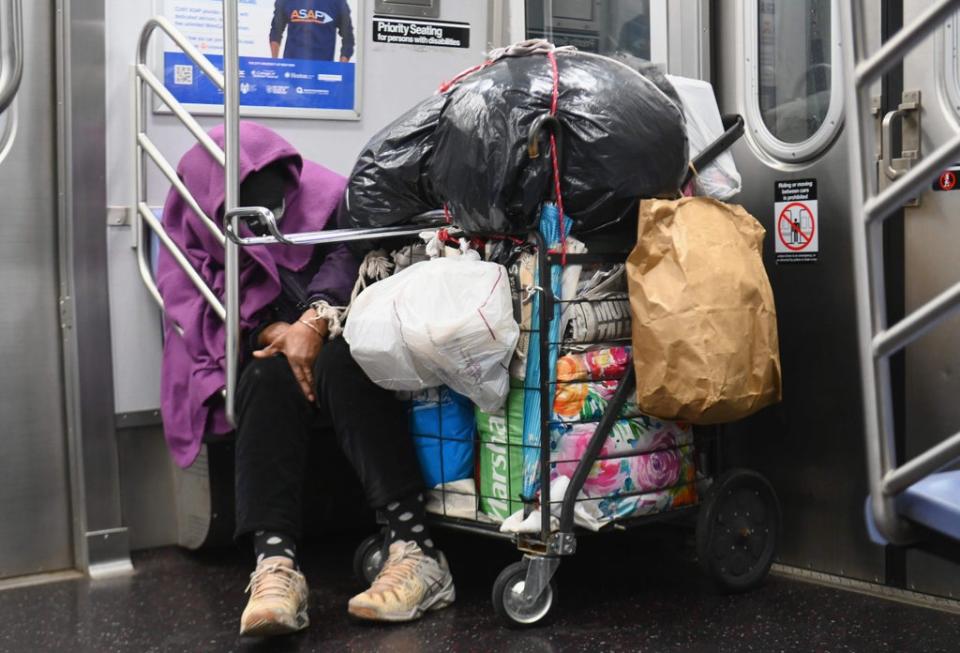
Ms Simone explains that there is no accurate measurement of New York City’s unsheltered homeless population but research shows that it is more likely to consist of single adults.
Studies have also found that most unsheltered homeless people are suffering from mental illness or severe health issues and that homeless single adults typically have higher rates of serious mental illness and addiction disorders than people from homeless families.
Ms Simone warns that a slight dip in families living in shelters throughout the pandemic could also soon be reversed after New York’s moratorium on evictions came to an end this month.
While the worsening situation has led to a rise in violence among displaced people, Ms Simone cautions against making the assumption that homeless people are prone to being violent.
“It’s important to note that not all people who are homeless are violent and not all people who are violent are homeless,” she says.
“Many crimes are committed by people who are stably housed but the headlines don’t tell you their housing status in the way they do if it’s a homeless person. So this demands a rethink.”
Rethinking the headlines
Ms Simone says that mental illness also does not mean a person will become violent.
“It’s important not to generalise that all homeless people or people suffering mental illness are dangerous based on a few heartbreaking and tragic examples,” she says.
“In fact, homeless people are more likely to be the victims than the perpetrators of crimes.”
Over the last four years, arrests at homeless shelters have actually consistently decreased, according to NYPD data.
The data, which represents arrests taking place at homeless shelters and does not reflect the location of the alleged offence or the suspect’s association with the shelter, shows that 725 arrests were made in the first three quarters of 201 - down from 758 in the same period in 2020 and from 1,648 before the pandemic began in 2019.
“The bottom line is that we clearly have a historic housing crisis in the US and the pandemic has highlighted that vulnerability in the housing system,” says Ms Simone.
“We know that housing is an impactful way to address homelessness and mental illness so it would significantly improve everyone’s public safety if we helped everyone get this stability.”
The focus should be on “preventative” measures so that people do not fall through the cracks of society and degenerate into violence, she says.
“I think are variety of reasons why we need to ensure people have access to stable housing and adequate mental health support and advancing public safety is one of them,” she says.
“Not all people with mental illnesses are violent but if people are able to fall through the social safety net and not receive the mental healthcare and stable housing they need in order to thrive, it makes everyone less safe - both that person and the people they encounter.”
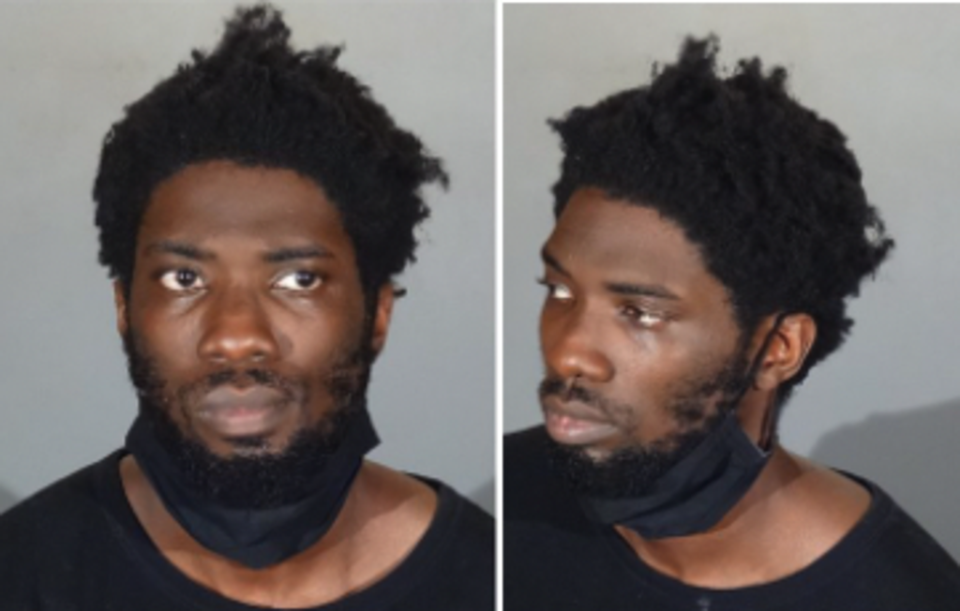
Rev. Bales says there needs to be a FEMA-like response to help get LA’s homeless population into emergency shelters and provide mental health and addiction support and conservatorships to those in need.
“There are 70,000 people on the streets every night just in LA - it’s a recipe for disaster,” he says.
“We have a hero on her way to work ready to give herself away at the hospital and retire soon and she loses her life without any real cause or reason.
“Then another lady is shoved in front of a train in New York and another lady is stabbed to death in a furniture store - it’s too much.”
Violence against women
And the reality is that women - like these three victims - are often seen as easy targets of random acts of violence, Christian Nunes, president of National Organization of Women (NOW) tells The Independent.
“Unfortunately women just become the targets so quickly in society which is why we have to continually work to protect women and girls,” she says.
Ms Nunes explains that all types of violence against women have risen over the last couple of years - something that is being driven by society’s perception of women.
“Since Covid-19 happened, violence against women has escalated - we’re seeing more domestic and partner violence, sexual violence, and violence both in the home and in frontline spaces,” she says.
Ms Nunes puts this down to an increase in misogyny and toxic masculinity and a growing anti-feminist movement in society.
“Misogyny and toxic masculinity has become more socially acceptable and society has become desensitised to the value of women,” she says.
Ms Nunes says this is evident in the treatment of sexual assault survivors who are blamed while their attackers walk free and in the likes of abortion laws saying that “women don’t have a right to make decisions for their own bodies”.
“As we become desensitised to the mistreatment of women it then becomes easier to become more desensitised to violence against women,” she says.
“There’s also an anti-feminist movement where any time a woman stands up for herself and talks about misogyny, people turn it into a negative and blame feminism.
“What that turns into is an internalised aggression towards women, aggression turns to hatred and hate turns to violence.”

These “underlying issues with how women are perceived” and the growing acceptance of this treatment of women filters into all parts of society, says Ms Nunes, making women vulnerable as targets of random attacks.
Ms Nunes says laws on gender-based violence and better access to mental health resources could go some way to improving public safety for women like Ms Go, Ms Shells and Ms Kupfer.
“It’s our responsibility collectively as a society to stop being desensitised to violence - it’s not the norm and it’s not acceptable,” she says.
Michelle Alyssa Go should be able catch a train, Sandra Shells should be able to wait for a bus, and Brianna Kupfer should be able to work her shift in a furniture store without fear.
As Ms Nunes says: “They should not have to live in fear at all.”

